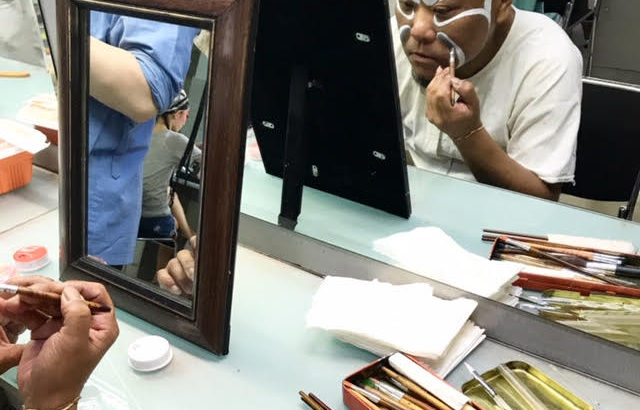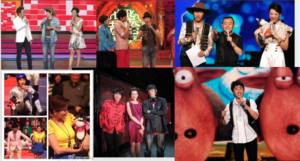An amazing 5 hour show deserves a review that is long and hefty, but I understand those that only want to read about certain artists so I will number the paragraphs.
1 RFD Boys
2 AHI
3 Pokey LaFarge
4 Joan Osborne’s Dylanology featuring Jackie Greene
5 I’m With Her
6 Rufus Wainwright
7. Peter Mulvey
1. The first band to take the stage was the RFD Boys. The RFD Boys play bluegrass, which is the folk music you think of when imaging hillbillies playing banjos in Kentucky. The group has been playing together for 50 years and still has three of the original members. One of the new members and also the lead guitarist for the band is the son of one of the original lead singer. The son was outstanding. His voice had a thick country accent when he sang that fits bluegrass perfectly. He sang better than his father. The group sounded best when they were singing together, usually in the humming and refrains of the songs. The fiddle player (I usually say violinist, but after seeing a folk festival I realize there is a huge difference between a violinist and fiddle player) was also a great bass singer that wove all the voices together. He was a perfect accompaniment for the rest of the group. My favorite song they played was Turkey in the Straw. In this song I was able to hear all the different instruments they were playing (violin, guitar, and banjo) play over the same riff.
2. The next group to take the stage was AHI. AHI isn’t anything like a bluegrass band. They describe their style as a mix of Marley, Michael Jackson, Tupac, but I thought they sounded like a christian rock band. His lyrics were Gospel and made me think of God, the Crescendo’s were slow and uplifting, and the drum beats reminded me of contemporary christian rock groups like Hillsong. I loved the lead singer’s voice, it was rough and rocky like Rod Stewart. The guitarist played solo’s on acoustic and electric guitars. Electric guitar solos are always king, but something special about the acoustic solo is the “clang” sound you can get from a strong pluck. I think folk music really loves “clanging”. My favorite song they performed was a Sam Cook cover A Change is Gonna Come. They had a great slide guitar for this song.
3. Pokey Lafarge was like a 1940’s performer came through a time machine to perform for us. His clothes, hair, guitar, music style, way of talking, jokes, all of it was from a previous century. He’s a character like his name implies. Pokey had a showman’s personality and great stories, he should part-time as an MC. My favorite song he played was Arkansas, in this song he sounded like Bob Dylan from the album Nashville Skyline. For his last song, Pokey did something I really appreciated. He went of his mic and unplugged his guitar. Sound engineering is really amazing, but folk music doesn’t need so much reinforcement, it was nice to dial it back a little and hear the guitar naturally. This also showed how powerful Hill auditoriums acoustics are. One man with a guitar, and I could still hear crystal clearly up in the mezzanine of an auditorium that seats 3,500 people. Pokey had a line that really stuck with me “Even bums get lucky sometimes”. I think this will be the new motto of my life.
4. The show hit a new level of wonderful when Joan Osborne’s Dylanology featuring Jackie Greene came on. These are special artists that took upon the task of only playing covers of Bob Dylan songs. Joan Osborne has a voice with a lot of emotion, perfect for slow songs and folk music. Jackie Greene was the only real guitarist of the night combining folk and rock & roll into powerful riffs, chords, and solos. I would say I’m a Bob Dylan fan, but most of the songs they played I could not recognize. Songs that I did recognize they altered so much that I could only recognize them from the lyrics. They radically changed Bob Dylan’s song and turned his folk sound into a dramatic jazz feel, or bluesy funk feel, or grand concert feel. The sound was different depending on whether the pianist was on the electric piano or grand piano. Some great songs they played were Highway 61 Revisited, Gotta Serve Somebody, and Knockin’ on Heaven’s Door.
5. I’m With Her is an up and coming group comprised of three young women. Contrary to what I first believed, they came up with the name before Hillary Clinton. This group was on after intermission and brought the night back to a more traditional folk sound. For their age they sounded very experienced. I enjoyed their formation, all three huddled around one mic with the lead singer always in the middle of the trio, and the fact they all played multiple instruments. All three singers had their own attributes. Sarah Jarosz had the most authentic country twang to her voice, Aoife O’Donovan had the most melodic voice great for hitting softer notes, and Sara Watkins had the most powerful voice that provided the best base to harmonize around. However, this group was my least favorite performance of the night. I thought the fiddle playing was pretty weak, it sounded amateurish with a lot of missed notes. The rest of the instrumentals was nothing special. My favorite song of theirs, and also the debut of the song, was Call My Name.
6. Rufus is the singer of Hallelujah in Shrek, making him forever a legend. Rufus has the voice of an angel, it is simply his voice that makes him so special. The level of clarity and resonance in his voice is something I have never heard before. It’s a gift from God and Rufus used this gift well. His voice has a boyish sound to it and he hits every high note with a natural strength that he can hold in a note for over 30 seconds. I was excited when he walked out on stage because of how crazily he was dressed. It reminded me of a homeless person, but it is how I would expect someone who is a genius and crazy (in his case crazy genius and crazy) would dress. He is a great piano player whose fingers fly around the keyboard, but his voice doesn’t need anything accompanying it to sound magnificent. Rufus obviously knows this because he performed an entire song just singing with his voice. His style is something I would never associate with folk, it is like a eerie beautiful style I expect from the Phantom of the Opera. I appreciated that Rufus didn’t like pauses between his songs and as soon as he finished a song would go on to the next; he didn’t even wait for the applause. I think that he was in a bit of a rush because it was his husband’s birthday and he probably wanted to Skype him. My favorite song he played was Early Morning Madness.
For the encore Rufus brought out all the magicians to join him in singing Hallelujah. Rufus sang the first and last chorus, in-between choruses were sung by other artists, and the refrain was sung by everyone. I thought this was mean of Rufus. No one can compare to him when singing this song, and even Jackie Greene and Joan Osborne sounded like amateur’s in their choruses. This song brought my friend, who I made at the show, cry, and he was older man.
7. The last musician was actually the MC for the show. Peter Mulvey didn’t just talk like most MC’s, he sang songs. This is the best kind of MC. Peter has an extremely soothing voice and is sneakily very good at guitar. I thought of Peter like ginger with sushi. I eat ginger between every piece of different fish to clean my palette for the next piece of fish. My favorite song he played was a stream of consciousness song called Pigeons.
I attached some photos below (sorry they aren’t too clear).













